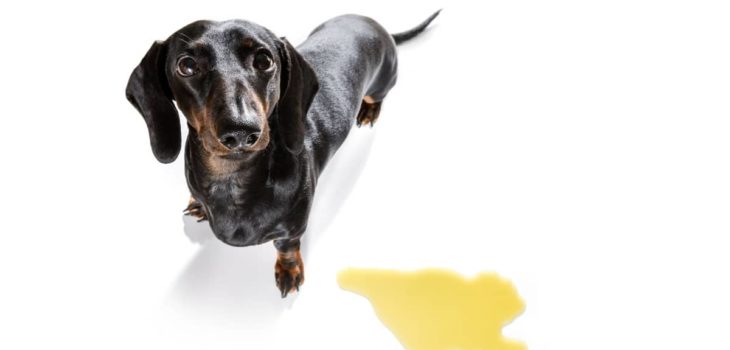Getting a doxie might not mean getting a puppy, and rescue dogs win over hearts and prompt the question of how to potty train an older dachshund? Providing a senior dog with a home is an admirable endeavor, but it will come with some challenges.
Rescue dogs might not have had any housetraining due to a lack of appropriate one-on-one care. Older dogs are not as energetic as puppies but have no difficulties in warming up to their new family. With that eagerness to please, potty training an older dog can be quite easy in some cases.
Why Would Older Dogs Not Be Housebroken?
There can be very simple explanations for why an older dog has seen no potty training. The most basic one is that maybe no one took the time to train them. Potty training takes time and not everyone is willing to invest that time.
An older dog could have been rescued off the street so they never saw the inside of a home before. Lastly, there is also the possibility that an older dog has lived a long while in a rescue home. This can mean they did not have the freedom of a whole house and only saw the enclosure.
Housebreaking An Older Dog

Can an older dog still be potty trained and what is considered old for a dachshund? Deciding when a dachshund is a senior dog depends on their physical state as much as their age. Usually, after the age of 10, a dachshund can have the title of a senior dog.
As for whether an older dog can be potty trained, the answer is a simple yes. The phrase you can’t teach an old dog new tricks doesn’t apply to this, but it will not be easy. Potty training a puppy isn’t that much easier though.
How To Potty Train An Older Dachshund With A Routine?
Establishing a daily routine goes into every kind of training including potty training. A few tools will also come in handy when trying to housebreak, such as a crate, or pee pads. Start with breakfast and feed your new dog their meal.
Don’t leave the food for more than 15 minutes if they haven’t touched it. This will keep them on a tight schedule and establish meal times as well. After breakfast, it’s time to take your dachshund outside using a leash, even if just going in the garden. If nothing happens, put them in a crate and try again in ten minutes.
When they do relieve themselves outside, encourage with praise and treats. At night, after dinner is another time to take the dog out, and provide several opportunities throughout the day. This will be especially important in the beginning when trying to establish the potty area outside.
There may be incidents when the older dog will pee inside the home right after peeing. This means they did not have enough time to pee outside but also smell around and get exercise. Dogs like to circle around before finding that perfect spot, it’s a natural instinct.
PoochPad Original Reusable Potty Pad
How To Potty Train An Older Dachshund Using A Crate?
Supervising your pet is how you will be able to correct behaviors, but when that isn’t possible, crating will help. A crate is a very useful tool in training a dog, particularly in the beginning, for both puppies and older dogs. The first few days will be the hardest, and using a crate to secure them, especially at night, is key.
Using a leash to hold your dog close indoors is another way to supervise them. Gradually let them have more and more freedom over a few days or even weeks. This method also gets a dog ready for leash walking and outdoor exercise.
Knowing When Your Dog Needs To Go
Understanding how to potty train an older dachshund is one thing, recognizing when they ask to go is another. There will be clear indications that a dog asks to go out so that they may answer nature’s call.
Some of these signs may include whining, leaving or pacing the room, circling, and even looking at the door. These are just a few indicators and your dog may have different ways to signal you.
It’s important to pay attention as dogs do try and communicate nonverbally as this works both ways. If you manage to interpret and take action, your dog will know how to get your attention.
Additional Things To Consider
Figuring out how to potty train an older dachshund will go a lot smoother with plenty of patience. It’s not an easy thing to start training a dog especially if this is something you haven’t done before. Potty training older dogs will come with many accidents.
Whenever things don’t go the right way and pee ends up on the carpet, don’t punish your dog. This includes loud remarks or gesturing, instead take the dog outside right when you catch them in the act. The last thing you’ll want to do is scare them enough that they just sneak off and pee somewhere else.
After the business is done outside, clean the accident spot inside. There is an enzyme cleaner specifically to eliminate urine smells and discourage further accidents. If not using equal parts water and vinegar can work too.
It’s also a possibility that grass or dirt will not suit their potty needs. This is usually the case with dogs that had to spend a lot of time on concrete. Thus they won’t be used to other unusual surfaces. Just have patience, encourage them and maybe provide a quiet spot in a park or a backyard. In time they will get used to grass and other such surfaces.

Conclusion – How To Potty Train An Older Dachshund?
Patience is the name of the game when figuring out how to potty train an older dachshund. The same is true with puppies, and in many cases, it can be easier with an older dog. It’s possible that older dogs may recognize human facial cues better, and understand what is asked of them. Establishing a schedule is the surest way to start a successful potty training routine.





